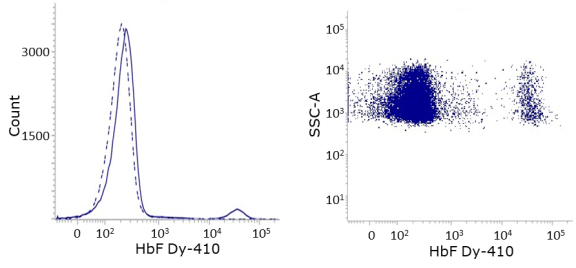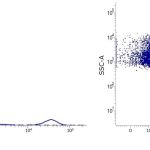
Anti-Hemoglobin F (HbF1) Monoclonal Antibody
$0.00
[ASR] Analyte Specific Reagent, analytical and performance characteristics are not established.
| Analyte Specific Reagent | Conjugation | Catalog # |
|---|---|---|
| Anti-Hemoglobin F (HbF1) | PURE Antibody | IQP-567P |
| Anti-Hemoglobin F (HbF1) | FITC Conjugated | IQP-567F |
| Anti-Hemoglobin F (HbF1) | R-PE Conjugated | IQP-567R |
| Anti-Hemoglobin F (HbF1) | Dy-410 Conjugated | IQP-567D |
The anti-hemoglobin F antibody recognizes the γ-chain of hemoglobin F (HbF). HbF is predominantly expressed by fetal erythrocytes and in some cases, HbF is also expressed by adult erythrocytes. These cells, so called F-cells, can represent up to 25% of the total erythrocyte population.
This antibody is characterized for flow cytometry applications and can be particularly useful during studies of sickle cell disease gene therapies that target HbF expression. Hemoglobin distribution within a sample can be assessed by analyzing the number of cells that carry HbF and/or hemoglobin S (HbS), an abnormal hemoglobin variant that causes sickle cell disease. This antibody can also be used to study hemoglobinopathies and fetal hemorrhage in maternal blood (also see Fetal Cell Count Kit).
1 vial of antibody at a concentration of 50 ug/mL in a solution of 0.01 M sodium phosphate, 0.15 M NaCl; pH 7.3, 0.2% BSA, 0.09% sodium azide (NaN3).
Store the vial at 2-8 °C. Monoclonal antibodies should be protected from prolonged exposure to light. Reagents are stable for the period shown on the vial label when stored properly.
| Clone | WBAC HbF1 |
| Isotype | IgG1 |
| Specificity | The HbF1 antibody reacts with the γ-chain of the human fetal hemoglobin molecule in its intact form. Reactivity is seen with human fetal erythrocytes, adult F cells (adult erythrocytes expressing hemoglobin F), and nucleated red cell precursors containing HbF. No binding is observed with other forms of human hemoglobin, including HbA, HBA2, HBA1C, HbS, and HbE. Binding is not observed in ELISA assays for purified hemoglobin alpha or gamma globulin chains alone, indicating the binding epitope is present on the intact HbF molecule only. HBF1 is at a different epitope on fetal hemoglobin from HBF2 clone, but has similar binding affinity as measured by flow cytometry and ELISA methods. |
| Applications | Flow cytometry |
Clone WBAC HbF1
Isotype IgG1
Specificity The HbF1 antibody reacts with the γ-chain of the human fetal hemoglobin molecule in its intact form. Reactivity is seen with human fetal erythrocytes, adult F cells (adult erythrocytes expressing hemoglobin F), and nucleated red cell precursors containing HbF. No binding is observed with other forms of human hemoglobin, including HbA, HBA2, HBA1C, HbS, and HbE. Binding is not observed in ELISA assays for purified hemoglobin alpha or gamma globulin chains alone, indicating the binding epitope is present on the intact HbF molecule only. HBF1 is at a different epitope on fetal hemoglobin from HBF2 clone, but has similar binding affinity as measured by flow cytometry and ELISA methods.
Applications Flow cytometry
